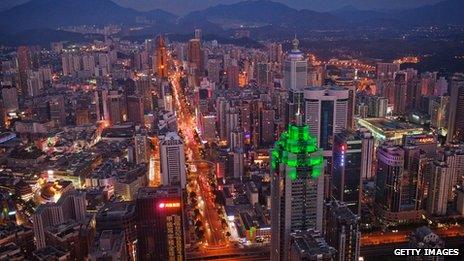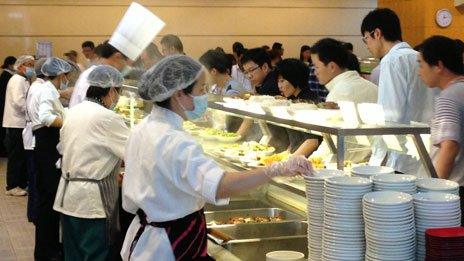China diary: Shenzhen gets smarter
- Published
- comments

I'm in China this week, filming at companies which in their different ways, show the new face of this country's hi-tech economy. The reports will be broadcast in a couple of weeks, but I hope to give you just a flavour of what we are seeing.
Our first stop is Shenzhen, the former fishing village which in little more than 30 years has grown into a sprawling metropolis.
This is where China's economic revolution started and where we may see its next stage as companies try to compete at the highest level with innovation, as well as low-cost manufacturing.
We arrive here at 01:00 local time, having crossed the border from Hong Kong at midnight so as to comply with our visa dates.
A few hours later, bleary-eyed and jet-lagged, we leave our hotel (it looks like it has been airlifted from Las Vegas), and head onto the traffic-choked roads of a city that just keeps on growing.
As an American who works here for one of the biggest technology firms tells us, "It doesn't pay to leave here for a week or two - it will have changed by the time you get back."
Everywhere there is construction, with high-rise blocks springing up to house middle-class families at rents which, according to our Chinese guide, might look pricey even in London.
We leave the motorway at a junction marked with two destinations, each sizeable towns in themselves: Foxconn to the left, Huawei to the right.

We want to visit the Taiwanese-owned Foxconn plant, one of the world's biggest factories and the place where Apple's iPhone is made.
But our request to film there has been met with a polite refusal on the grounds of commercial confidentiality. Foxconn has been at the centre of concerns about working conditions in Chinese plants, although as manufacturing wages in Shenzhen soar, the company is moving many jobs to inland China.
Instead, we head to Huawei, a company that sees itself as very different beast from its neighbour (although one executive there tells us that conditions at Foxconn are much better than they have been painted).
This telecoms equipment business, competing head-to-head with American and European giants, has a skilled workforce earning many times what a mobile phone assembler makes.
For most of the 40,000 people working on this tree-lined campus - and yes, it does feel like a university - are engineers with a degree or often a Master's.
We are driven around a site with an interesting collection of buildings, from standard plate-glass towers, to lakeside villas where customers are entertained, and on to what appears to be a replica of the White House.
Then we watch at noon, as thousands of engineers headed to a series of cafeterias dotted across the campus.
The place might feel like a Google or a Microsoft, but there's no free food here. They all line up for what smells like a delicious meal, pay their money and eat speedily so as to grab a bit of downtime. At as much as £5 for a buffet with seafood it's good value, but way beyond the wage packet of a Foxconn worker.

I interrupt a couple of young engineers, Yin Ping and Xi Jie, as they finish their lunch to ask them about their backgrounds. They are not from Shenzhen - nobody in fact is "from" Shenzhen - but from the same part of the Chinese countryside about 400 miles away.
Each has studied hard and competed against many others for a job at a company which, although it recruited 10,000 new staff last year, can have the pick of Chinese graduates.
These clever young men, leading lives unimaginably different from those of their parents, may be representative of the new China. Huawei certainly thinks so.
Mind you, this is a company seen rather differently in the US, where a congressional committee recently painted it as a cybersecurity threat controlled by the Communist Party. More on that when our report on Huawei is broadcast.
In the meantime, more from Shenzhen and then Beijing later this week.